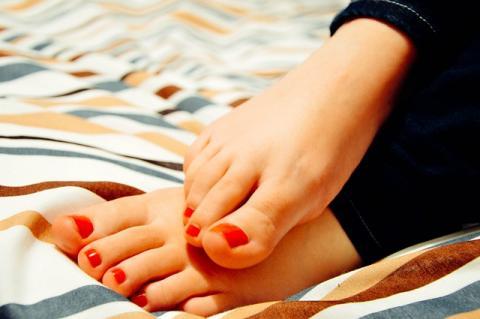
Athlete’s Foot can be very uncomfortable, embarrassing, and sometimes painful. Today’s walk through Mother Earth’s Medicine Cabinet will lead you down a section of all-natural antifungal and antibacterial healers.
Athlete’s Foot (Tinea Pedis)
Athlete’s foot is a fungal infection located on the skin and underneath the toenails of the feet. In some rare cases, athlete’s foot (so-called due to its prevalence in athletes) can actually spread to the hands. Tinea pedis is fairly contagious and spreads easily to the next victim.
The tinea fungus is the cause of the infection. Just like many fungi, this one thrives in moist, warm environments. Even if you are not prone to dealing with athlete’s foot it can still be passed to you by walking barefoot in places like public showers, pools, locker rooms, around swimming pools, and many other places where people walk barefoot. If you frequent these places you may want to invest in water shoes or flip-flops to avoid catching the itch.
Signs & Symptoms
-
Itching, stinging and burning between your toes or on the soles of your feet.
-
Cracked, peeling skin.
-
Itchy blisters (in particularly bad cases).
-
Raw, red-colored skin.
-
Discolored toenails that become weak and crack.
What Does Mother Earth’s Medicine Cabinet Hold For Healing?
-
Tea Tree Oil: Tea tree oil is very well known for its antifungal and antiseptic properties. It is those antifungal and antiseptic properties that destroy fungus, as well as prevent any further spreading. Tea tree oil is used topically to treat various skin infections including athlete’s foot, scabies, acne, ringworm, fungal infections, bacterial infections, and even lice. You can make a footbath by adding 30-40 drops of 100% tea tree oil to the warm water. Soak your feet for about 15-20 minutes twice a day.
-
Raw Garlic: Garlic is an incredible addition to many recipes because of the great flavor, as well as for the healing it brings. Garlic contains allicin, which is the active compound that inhibits the growth of the fungus wreaking havoc on your feet. Not only will raw garlic treat the infection but it will also help prevent another breakout. Allicin is the star player when it comes to antibacterial, antioxidant, and antimicrobial properties that also aid the healing of athlete’s foot. Simply crush one whole garlic clove and add enough water to make a paste. Spread the paste on the affected area. Leave it alone for 20 minutes, and then wash it off with some tea tree infused soap.
-
Vinegar: White vinegar and apple cider vinegar can both be useful for treating the fiery foot itch. The acidic properties of both kinds of vinegar are responsible for killing the tinea fungus. The same acidic properties that fight the fungus also lower the alkaline levels of our skin, which, in turn, inhibits the growth and spreading of the fungus. Vinegar is also helpful in drying out the moisture in your feet which is one of the underlying causes of bacteria and fungus growth. Make a foot soak using 1 part vinegar and 3 parts warm water. Soak your feet for 15 minutes two times a day for 7 days or until the infection is gone.
-
Cinnamon: Cinnamon is often used to help treat coughs and colds but there’s far more to the cinnamon stick. The leaf of the cinnamon tree contains an essential oil that contains antioxidants and has very potent antifungal properties, as well as antibacterial and even antiperspirant properties, too. This is a two-in-one for treating athlete’s foot because of the fact that it fights the fungus and helps keep your feet from sweating. Add a couple of drops of the oil into your footbath and soak for about 20 minutes. You can also break 10 cinnamon sticks into smaller pieces, add them to boiling water, simmer for 5 minutes, steep for 45 minutes, and soak your feet for 30 minutes.
-
Neem Oil: Neem oil is often used in Ayurvedic medicine and healing. This is because of its antiviral, antifungal, and antibacterial properties. The essential oil is used to treat numerous skin issues and infections similar to those treated with tea tree oil. You can make an athlete’s foot oil by combining 1 tablespoon of the neem oil with a half of a cup of a carrier oil. I suggest using sweet almond oil as the carrier oil because it is great for the skin. Sweet almond oil contains vitamin E, potassium, zinc and monounsaturated fatty acid which benefits the skin and hair.
Athlete’s foot can be a nuisance but it doesn’t have to be. There are plenty of natural remedies and treatments out there that are available -- some of them might even be right outside of your back door. Antifungal pastes, creams, and powders can become pretty expensive and some of the over-the-counter medicine contains many unnecessary chemicals and fillers. Why not reach for something natural that you can pronounce? As always, I hope this walk through the medicine cabinet finds you well and in a good way. Happy Healing!








